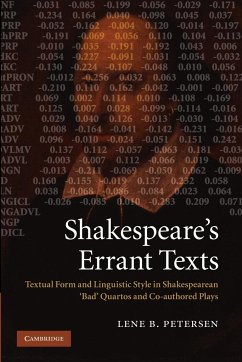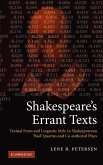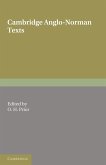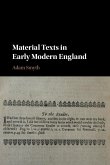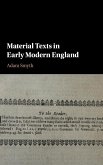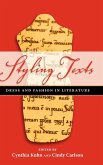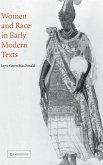Lene B. Petersen
Shakespeare's Errant Texts
Textual Form and Linguistic Style in Shakespearean 'Bad' Quartos and Co-Authored Plays
Lene B. Petersen
Shakespeare's Errant Texts
Textual Form and Linguistic Style in Shakespearean 'Bad' Quartos and Co-Authored Plays
- Broschiertes Buch
- Merkliste
- Auf die Merkliste
- Bewerten Bewerten
- Teilen
- Produkt teilen
- Produkterinnerung
- Produkterinnerung
Using case studies of Hamlet, Romeo and Juliet and Titus Andronicus, this book examines what constitutes a 'Shakespearean text'.
Andere Kunden interessierten sich auch für
![Shakespeare's Errant Texts Shakespeare's Errant Texts]() Lene B. PetersenShakespeare's Errant Texts92,99 €
Lene B. PetersenShakespeare's Errant Texts92,99 €![Cambridge Anglo-Norman Texts Cambridge Anglo-Norman Texts]() Cambridge Anglo-Norman Texts25,99 €
Cambridge Anglo-Norman Texts25,99 €![Material Texts in Early Modern England Material Texts in Early Modern England]() Adam SmythMaterial Texts in Early Modern England29,99 €
Adam SmythMaterial Texts in Early Modern England29,99 €![Material Texts in Early Modern England Material Texts in Early Modern England]() Adam SmythMaterial Texts in Early Modern England89,99 €
Adam SmythMaterial Texts in Early Modern England89,99 €![Working on Texts Working on Texts]() Enrico TerrinoniWorking on Texts28,99 €
Enrico TerrinoniWorking on Texts28,99 €![Styling Texts Styling Texts]() Styling Texts105,99 €
Styling Texts105,99 €![Women and Race in Early Modern Texts Women and Race in Early Modern Texts]() Joyce Green MacDonaldWomen and Race in Early Modern Texts61,99 €
Joyce Green MacDonaldWomen and Race in Early Modern Texts61,99 €-
-
-
Using case studies of Hamlet, Romeo and Juliet and Titus Andronicus, this book examines what constitutes a 'Shakespearean text'.
Hinweis: Dieser Artikel kann nur an eine deutsche Lieferadresse ausgeliefert werden.
Hinweis: Dieser Artikel kann nur an eine deutsche Lieferadresse ausgeliefert werden.
Produktdetails
- Produktdetails
- Verlag: Cambridge University Press
- Seitenzahl: 332
- Erscheinungstermin: 8. Mai 2013
- Englisch
- Abmessung: 229mm x 152mm x 18mm
- Gewicht: 482g
- ISBN-13: 9781107625556
- ISBN-10: 1107625556
- Artikelnr.: 39360011
- Herstellerkennzeichnung
- Libri GmbH
- Europaallee 1
- 36244 Bad Hersfeld
- gpsr@libri.de
- Verlag: Cambridge University Press
- Seitenzahl: 332
- Erscheinungstermin: 8. Mai 2013
- Englisch
- Abmessung: 229mm x 152mm x 18mm
- Gewicht: 482g
- ISBN-13: 9781107625556
- ISBN-10: 1107625556
- Artikelnr.: 39360011
- Herstellerkennzeichnung
- Libri GmbH
- Europaallee 1
- 36244 Bad Hersfeld
- gpsr@libri.de
Lene B. Petersen's work centres on Shakespearean textual studies, corpus linguistics/authorship and attribution studies and Renaissance theatre history. She has also written on traditional folk ballads and their transmission.
Foreword; Prologue; Part I. Oral-Memorial Transmission and the Formation of
Shakespeare's Texts: 1. The Elizabethan dramatic industry and industrious
Shakespeare; 2. Decomposing the text: oral transmission and the theory of
the Zielform; 3. The popular play and the popular ballad: evidence of
'Quarto mechanics' in the multiple texts of Hamlet and Romeo and Juliet;
Conclusion Part I; Part II. Recomposing the Author: Some Tools for
Positioning the Role of the Playwright in Dramatic Transmission: 4.
Introduction to quantitative textual analysis: computational stylistics,
cognition and the missing author; 5. Stylometry and textual multiplicity I:
contextual stylistics and the case of Titus Andronicus; 6. Stylometry and
textual multiplicity II: testing the grading between authorship and
'orality' in the scenes of Romeo and Juliet and Hamlet; Conclusion Part II:
evaluating the experiment; Epilogue; Appendix I. Scenic units in Q1
Hamlet/Der Bestrafte Brudermord and Romeo and Juliet/Romio und Julietta;
Appendix II. 'Meet it is I set it downe': verbal evidence of Quarto
mechanics in the short versions of Hamlet and Romeo and Juliet; Appendix
III. Chapter 4: table of results for 257-Plays DA, using 50 principal
components; Appendix IV. Examples of principal component screen plots for
three-text Hamlet by scenes and three-text Romeo and Juliet by scenes only;
Bibliography.
Shakespeare's Texts: 1. The Elizabethan dramatic industry and industrious
Shakespeare; 2. Decomposing the text: oral transmission and the theory of
the Zielform; 3. The popular play and the popular ballad: evidence of
'Quarto mechanics' in the multiple texts of Hamlet and Romeo and Juliet;
Conclusion Part I; Part II. Recomposing the Author: Some Tools for
Positioning the Role of the Playwright in Dramatic Transmission: 4.
Introduction to quantitative textual analysis: computational stylistics,
cognition and the missing author; 5. Stylometry and textual multiplicity I:
contextual stylistics and the case of Titus Andronicus; 6. Stylometry and
textual multiplicity II: testing the grading between authorship and
'orality' in the scenes of Romeo and Juliet and Hamlet; Conclusion Part II:
evaluating the experiment; Epilogue; Appendix I. Scenic units in Q1
Hamlet/Der Bestrafte Brudermord and Romeo and Juliet/Romio und Julietta;
Appendix II. 'Meet it is I set it downe': verbal evidence of Quarto
mechanics in the short versions of Hamlet and Romeo and Juliet; Appendix
III. Chapter 4: table of results for 257-Plays DA, using 50 principal
components; Appendix IV. Examples of principal component screen plots for
three-text Hamlet by scenes and three-text Romeo and Juliet by scenes only;
Bibliography.
Foreword; Prologue; Part I. Oral-Memorial Transmission and the Formation of
Shakespeare's Texts: 1. The Elizabethan dramatic industry and industrious
Shakespeare; 2. Decomposing the text: oral transmission and the theory of
the Zielform; 3. The popular play and the popular ballad: evidence of
'Quarto mechanics' in the multiple texts of Hamlet and Romeo and Juliet;
Conclusion Part I; Part II. Recomposing the Author: Some Tools for
Positioning the Role of the Playwright in Dramatic Transmission: 4.
Introduction to quantitative textual analysis: computational stylistics,
cognition and the missing author; 5. Stylometry and textual multiplicity I:
contextual stylistics and the case of Titus Andronicus; 6. Stylometry and
textual multiplicity II: testing the grading between authorship and
'orality' in the scenes of Romeo and Juliet and Hamlet; Conclusion Part II:
evaluating the experiment; Epilogue; Appendix I. Scenic units in Q1
Hamlet/Der Bestrafte Brudermord and Romeo and Juliet/Romio und Julietta;
Appendix II. 'Meet it is I set it downe': verbal evidence of Quarto
mechanics in the short versions of Hamlet and Romeo and Juliet; Appendix
III. Chapter 4: table of results for 257-Plays DA, using 50 principal
components; Appendix IV. Examples of principal component screen plots for
three-text Hamlet by scenes and three-text Romeo and Juliet by scenes only;
Bibliography.
Shakespeare's Texts: 1. The Elizabethan dramatic industry and industrious
Shakespeare; 2. Decomposing the text: oral transmission and the theory of
the Zielform; 3. The popular play and the popular ballad: evidence of
'Quarto mechanics' in the multiple texts of Hamlet and Romeo and Juliet;
Conclusion Part I; Part II. Recomposing the Author: Some Tools for
Positioning the Role of the Playwright in Dramatic Transmission: 4.
Introduction to quantitative textual analysis: computational stylistics,
cognition and the missing author; 5. Stylometry and textual multiplicity I:
contextual stylistics and the case of Titus Andronicus; 6. Stylometry and
textual multiplicity II: testing the grading between authorship and
'orality' in the scenes of Romeo and Juliet and Hamlet; Conclusion Part II:
evaluating the experiment; Epilogue; Appendix I. Scenic units in Q1
Hamlet/Der Bestrafte Brudermord and Romeo and Juliet/Romio und Julietta;
Appendix II. 'Meet it is I set it downe': verbal evidence of Quarto
mechanics in the short versions of Hamlet and Romeo and Juliet; Appendix
III. Chapter 4: table of results for 257-Plays DA, using 50 principal
components; Appendix IV. Examples of principal component screen plots for
three-text Hamlet by scenes and three-text Romeo and Juliet by scenes only;
Bibliography.

